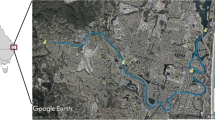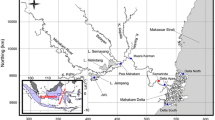Abstract
Morpho-hydrodynamic changes are one of the major problems affecting the abiotic sphere and the ecological status of water bodies. In order to assess the impact of the works carried out in the Bystroe Channel on the hydrodynamic and hydromorphological conditions of the Chilia and Old Stambul Danube branches, solid scientific based tools are required. Using MIKE 3 Flow Model and input data provided by in situ campaigns carried out by the National Institute for Research and Development in Environmental Protection Bucharest, an 8.5 km river length hydrodynamic model was developed, calibrated and validated in two independent river flow conditions. The model shown to provide high—confidence results (>90%) by comparative analysis of modelled versus measured values for water discharge and similarity in water velocity distribution for transversal control sections.
Access provided by Autonomous University of Puebla. Download conference paper PDF
Similar content being viewed by others
Keywords
- Hydrodynamic modelling
- Boundary conditions
- Model calibration
- Model validation
- Danube river
- Bystroe Channel
1 Introduction
Over time, the Danube River has undergone alteration processes that have affected the dominant natural systems and created structures for economic purposes (navigation, hydropower, agriculture, ports, etc.) that have led to the reduction of floodplains and changes in morphological structures. The Chilia Branch status is particularly important due to the fact that it acts as natural state border between Romania and Ukraine and from it branches the Bystroe Channel, for which intended increased navigability, works have been carried out since 2004 that lead to international intense debate over the adverse transboundary impact on the local hydrodynamic and hydromorphological conditions [1] and habitat loss for fish and birdlife [2, 3].
It is necessary to use techniques and tools [4] to help determine the correct spatio-temporal evolution of hydromorphological properties with impact on water quality [5]. Currently, high-performance software programs are available that ensure the development of numerical models with a high level of confidence in simulating the hydrodynamic and hydromorphological conditions of rivers [6]. With the evolution of technology, a series of programs have been developed related to the hydraulic modeling of water flow [7]. Given that the numerical models take into account all the elements that can influence the water dynamics (flow, bathymetry, riverbed roughness, etc.), by 3D modeling can be calculated hydrodynamic variables and sediment transport, water quality parameters can be determined and trends in riverbed morphology can be monitored [8].
2 Materials and Method
In order to develop a hydrodynamic model for the Chilia-Bystroe area, the first steps carried out consisted of modelling domain delineation by implementing the measured bathymetry values into the dedicated computational grid and setting up the boundary conditions and simulation parameters. Considering the extent of the 3D riverbed bathymetry data set provided by the high resolution multibeam measurements carried out by the National Institute for Research and Development in Environmental Protection Bucharest (INCDPM), the modelling domain covered an 8.5 km length river sector, as seen in Fig. 1.
The in situ campaigns carried out by INCDPM [9] provided data sets (Fig. 2) that were used for setting up the geometric model, boundary conditions (discharge and water level values) and water velocity distributions in control sections for the model calibration and validation.
The developed geometric model for the study area consisted of 17680 triangular elements and 9446 nodes in the horizontal plane and 10 sigma layers with variable thickness (2, 3, 4, 6, 8, 10, 12, 15, 20, 20%) in the vertical plane. The data used for the boundary conditions resulted from Acoustic Doppler Current Profiler (ADCP) single-beam measurements (water discharge) and from topometric measurements (water level) that were carried out in different hydrological conditions (Table 1).
The initial model was calibrated by gradually varying the parameters values until the modelling results were similar with the in situ measured values for the set flow conditions.
The model validation process consisted in setting up the boundary conditions for another data set recorded in different flow conditions and running the model by using the parameter values determined in the calibration process and compare the resulted modelled values with the measured ones.
3 Result and Discussion
The main simulation parameter that estimates the influence of the riverbed resistance in the Hydrodynamic module (HD) of MIKE 3 Flow Model is the roughness height (RH). For different RH values, 15 test models were run and the modelled discharge values were compared with the measured ones (Fig. 3). With resulted relative errors of −1.38% (C3) and −1.74% (C2), the optimum value for RH was determined to be 0.09 m.
As seen in Fig. 4 for a cross-section located below the bifurcation (Fig. 4a), another step in the model calibration process consisted in the comparative analysis of modelled (Fig. 4b) and measured (Fig. 4c) water velocity distributions for transversal sections. Figure 4 shows the similarity of the two distributions.
In the model validation process, a numerical simulation was carried out using the second data set from Table 1 for the boundary conditions and the determined 0.09 m value for RH. The resulted relative errors for modeled discharge values being below 10% (Table 2) and the water velocity modelled and measured distributions being similar, the hydrodynamic model for the Chilia—Bystroe area was considered validated.
4 Conclusion
Using MIKE 3 Flow Model, a software with international repute on solving challenges in water environments and results of in situ measurement campaigns carried out by INCDPM for the 3D bathymetry on which the geometric model was developed, for the boundary conditions and reference values for the model calibration and validation processes, the hydrodynamic model for the Chilia—Bystroe area had shown that it provides results with a high degree of confidence (>90%). The model will be updated with new data as it becomes available and it will be used for making short- and medium-term forecasts based on scenarios in order to assess the morpho-hydrodynamic changes for this area with strategic importance and their impact on migration routes and sturgeon habitats.
This paper was developed through Nucleu Programme—Contract number 39 N/2019 carried out with the Romanian Ministry of Research and Innovation support, within the project “Research on the morphological and hydrodynamic evolution tendencies in the Chilia—Bystroe transboundary area”.
References
Tudor G, Deak G, Cïrstinoiu C, Raischi M, Danalache T, Cornateanu G, Bratfanof E (2020) Transboundary river hydrodynamic conditions assessment in sustainable development context. A case study of Danube River: Chilia Branch -Bystroe channel area, IOP Conf. Series: Earth and Environmental Science 616, 012072. https://doi.org/10.1088/1755-1315/616/1/012072
INCDPM (2014) Study regarding the updating of the physical-chemical and biological components evaluation from Danube Delta and the adjacent coastline considering the transboundary impact of the Bastroe channel and establishing a transboundary monitoring system coordinated together with the Ukrainian part, in order to analyze the environmental impact on the Danube Delta Biosphere Reserve of the project regarding the construction of the deep sea navigation channel on the Bastroe branch, INCDPM Bucharest, INCDDD Tulcea, INCDM GA Constanţa, INHGA
Danalache T, Badilita AM, Deák G, Holban E, Popescu I, Daescu A, Raischi MC, Ghita G, Nicolae CG, Diaconescu S (2017) Assessment of Bâstroe channel possible impact on lower danube sturgeon migration, aquaculture, aquarium, conservation and Legislation. Int. J. Bioflux Soc 10(5):1011–1018
INCDPM (2017) PN 16 04 01 13.1: Current trends and approaches to the use of GIS techniques in the analysis of environmental factors, INCDPM
Gy D, Tudor G, Nicolae AF, Uriţescu B, C-tin C, Raischi MC, Zamfir S, Badea G, Danalache TM (2019) Hydrodynamic parameters assessment using specialized techniques in the context of low flows. Case study Epurasu Branch—Danube River, AIP Conference Proceedings 2129. https://doi.org/10.1063/1.5118097
Acuña GJ, Ávila H, Canales FA (2019) River model calibration based on design of experiments theory. A case study: meta river, Colombia, Water 2019(11):1382. https://doi.org/10.3390/w11071382
Sârbu D (2015) Strategies to minimize anthropogenic impact on riverbeds. Dissertation, Technical University of Civil Engineering—Faculty of Hydrotechnics, Bucharest, Romania
INCDPM (2015) PN 09 06 01 25.1 Use of numerical simulations to analyse the variation of hydraulic parameters in the context of anthropogenic interventions. Bala branch case study, INCDPM
INCDPM (2020) PN 19 43 03 01.3 Establishment of the morpho-hydrodynamic reference status for the Chilia—Bystroe area, INCDPM
Author information
Authors and Affiliations
Editor information
Editors and Affiliations
Rights and permissions
Copyright information
© 2022 The Author(s), under exclusive license to Springer Nature Singapore Pte Ltd.
About this paper
Cite this paper
Tudor, G. et al. (2022). Hydrodynamic Modelling for the Chilia—Bystroe Danube Sector: Model Calibration and Validation. In: Mohamed Noor, N., Sam, S.T., Abdul Kadir, A. (eds) Proceedings of the 3rd International Conference on Green Environmental Engineering and Technology. Lecture Notes in Civil Engineering, vol 214. Springer, Singapore. https://doi.org/10.1007/978-981-16-7920-9_17
Download citation
DOI: https://doi.org/10.1007/978-981-16-7920-9_17
Published:
Publisher Name: Springer, Singapore
Print ISBN: 978-981-16-7919-3
Online ISBN: 978-981-16-7920-9
eBook Packages: EngineeringEngineering (R0)








